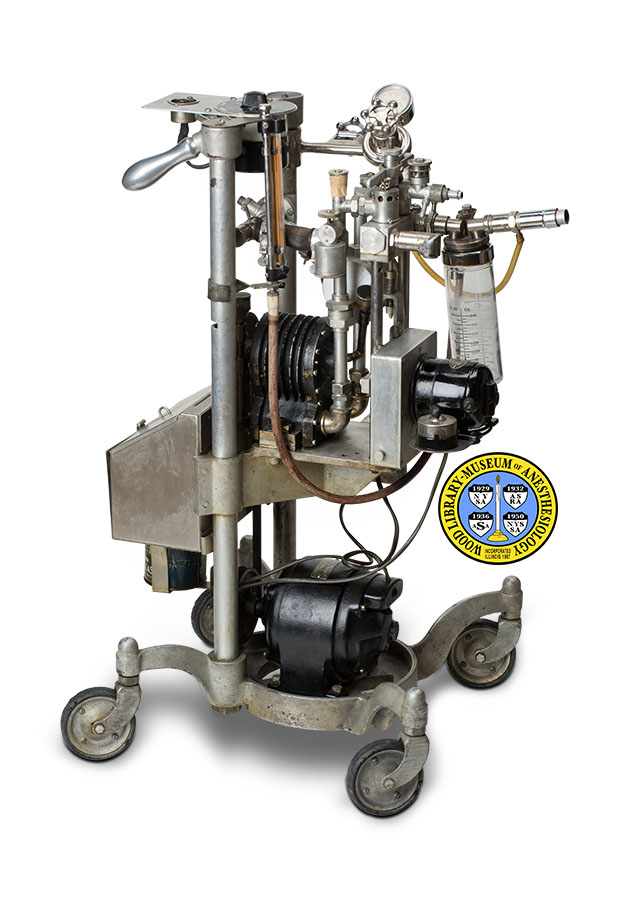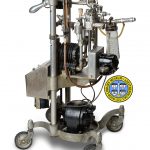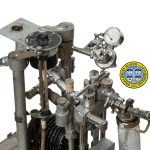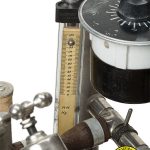Heidbrink Resuscitator
Anesthesiologists are responsible for managing the patient's vital functions, including respiration, during surgery. They may also be responsible for resuscitation of the surgical patient. Founded in 1910, the Heidbrink Company manufactured both anesthesia machines and resuscitation apparatus. The Ohio Company bought out Heidbrink around 1939, and continued to use the Heidbrink name on its equipment for decades. These products included several resuscitators designed by Joseph Kreiselman, M.D. (1895-1968). The apparatus seen here is by far the largest of these, the Kreiselman Model 51, weighing 100 pounds. It could be used either for the resuscitation of a patient who had stopped breathing, or for respiration therapy, maintaining a patient's breathing for an extended period of time. In 1942, the Model 51 was judged acceptable by the Council on Physical Therapy of the American Medical Association. That same year, it was featured in the textbook Clinical Anesthesia, by Dr. John S. Lundy (1894-1973). This example of the apparatus was donated to the WLM by the Mayo Clinic, where Dr. Lundy was the founding Chair of the Department of Anesthesiology.
Catalog Record: Heidbrink Resuscitator Heidbrink Resuscitator
Access Key: amyb
Accession No.: 66-116
Title: [Heidbrink resuscitator].
Author: Kreiselman, Joseph, 1895-1968.
Corporate Author: Heidbrink Company.
Title variation: Alt Title
Title: Heidbrink Adult Resuscitator.
Title variation: Alt Title
Title: Kreiselman Resuscitator Model 51.
Publisher: Minneapolils, MN : Heibrink Company, [between 1935 and 1945?].
Physical Description: 1 resuscitation apparatus : metals, plastics, glass, rubber; 88 x 58 x 58 cm.
Subject: Respiration, Artificial – instrumentation.
Subject: Resuscitation – instrumentation.
Web Link: https://www.woodlibrarymuseum.org/museum/item/1020/heidbrink-resuscitator
Note Type: General
Notes: The date range defines the decade surrounding the acquisition of Heidbrink by the Ohio Company (ca. 1939.) The Heidbrink Company advertised various other models of Kreiselman resuscitators in 1937. The object is marked “Heidbrink” and not “Ohio”, indicating the likelihood that it was manufactured before the acquisition. But Ohio continued to use parts so marked for a few years following the acquisition.The only two descriptions of this model found by the cataloger are both dated 1942. This opens the less likely possibility that this object was not just sold, but made, by Ohio. A less complex, manually operated model, for resuscitation only, was described by Dreisbach in 1955. The front of the apparatus is considered that side on which the glass humidifying bottle is mounted, facing the patient. The back is that side on which the handles and the rheostat are mounted.
Note Type: Citation
Notes: Dreisbach RH. Handbook of Poisons. Los Altos, CA: Lange Medical Publications, 1955:386-387.
Note Type: Citation
Notes: The Heidbrink Company. Directions for Assembly and Use of the Heidbrink Resuscitator (Kreiselman Model). Minneapolis: The Heidbrink Company, 1937.
Note Type: General
Notes: Heidbrink adult resuscitator, Kreiselman model 51-A, acceptable. [Council on Physical Therapy]. JAMA. June 27, 1942;119(9):711.
Note Type: Citation
Notes: Lundy JS. Clinical Anesthesia: A Manual of Clinical Anesthesiology. Philadelphia: Saunders, 1942:308.
Note Type: Physical Description
Notes: The object consists of three stages or levels of components, mounted on a four-wheeled base; The “spine” of the apparatus consists of two stout poles that rise from the base; The upper stage of the apparatus consists of a cap over the top of these poles; This cap consists of a flat bar marked “HEIDBRINK”; The cap holds two downward-angled handles, facing the back of the apparatus; Between the handles, and mounted at the highest point on the apparatus, is a metal plate that holds a rheostat; The control dial of the rheostat is marked, from left to right: “Low High”, with radial lines between these words; The Heidbrink logo, “Hi-Co”, appears on the left and right edges of the dial; On the bottom edge of the dial, from left to right, there is a blank space marked “No.”, then the marks: “Watts 575”, then the marks: “Volts 110-120”; When seen from the front, all of the marks on the rheostat appear upside-down;
The middle stage of the apparatus consists of a flat, square metal plate or platform that supports most of the components of the apparatus; A metal box is mounted at the front edge of this platform; A small motor is attached to the front of this box; This motor rests of a small shelf; Posts mounted behind this box hold more components, including an oxygen gauge, and a glass humidifying bottle (possibly the same as Heidbrink’s ether vaporizer); The connector that extends from the head of this bottle stands furthest forward of all the machine’s components; At the back of this platform is a large metal component that is shaped like a concertina, which is painted black; Two posts connect to this component; Each of these posts supports additional components; This platform also holds a tool box that is mounted on the back of the poles; Attached to the tool box is a container to hold a can of lubricant for the motors;
The bottom stage of the apparatus consists of a flat circular platform with a raised rim; A motor rests on this platform; This motor is roughly twice the size of the motor that is mounted above it; The wheel castors are integrated into this base; The rubber wheels are in very poor condition.
Note Type: Reproduction
Notes: Photographed by Mr. Steve Donisch, January 13, 2016.
Note Type: Acquisition
Notes: Donated to the WLM by the Department of Anesthesiology, Mayo Clinic, Rochester, MN, in 1966.
Note Type: Historical
Notes: Anesthesiologists are responsible for managing the patient’s vital functions, including respiration, during surgery. They may also be responsible for resuscitation of the surgical patient. Founded in 1910, the Heidbrink Company manufactured both anesthesia machines and resuscitation apparatus. The Ohio Company bought out Heidbrink around 1939, and continued to use the Heidbrink name on its equipment for decades. These products included several resuscitators designed by Dr. Joseph Kreiselman (1895-1968). The apparatus seen here is by far the largest of these, the Kreiselman Model 51, weighing 100 pounds. It could be used either for the resuscitation of a patient who had stopped breathing, or for respiration therapy, maintaining a patient’s breathing for an extended period of time. In 1942, the Model 51 was judged acceptable by the Council on Physical Therapy of the American Medical Association. That same year, it was featured in the textbook Clinical Anesthesia, by Dr. John S. Lundy (1894-1973). This example of the apparatus was donated to the WLM by the Mayo Clinic, where Dr. Lundy was the founding Chair of the Department of Anesthesiology.
Note Type: Exhibition
Notes: Selected for the WLM website.




